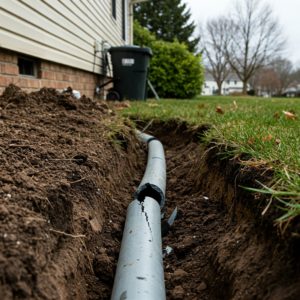WHEN DO YOU NEED TO REPLACE YOUR SEWER LINE?
Many of us don’t think twice about our home’s sewer pipes. After all your pipes are hidden behind walls and in the ground. It’s not uncommon to think that our sewer pipes will last as long as our home does, unfortunately, this isn’t entirely realistic.
Although your sewer pipes are durable, they will need replacement, eventually. There are many factors that can attribute to a sewer replacement. We are here to help you understand what to expect.
How long should a sewer line last?
As mentioned above there are a number of different factors that can attribute the life expectancy of a sewer line. Age is a factor along with the type of material your sewer line is constructed out of. You may not notice many signs of deterioration aside from the occasional drain clog. Below is a chart to help you better understand the life expectancy of your sewer line. In some cases, you might need to replace your sewer line sooner.
- Orangeburg Pipe: Made of wood and pitch, it’s brittle and lightweight. It is known for structural degeneration after extended use. Life expectancy 50 years.
- Clay Pipe: Clay pipes were an economical way for builders and sewer workers to create a main sewer line prior to 1980. Life Expectancy 50-60 Years.
- Cast Iron Pipe: Deterioration of cast iron pipes is normal after just 25 years. Wear and tear is normal in residential pipe systems. Life Expectancy 50 – 100 Years.
- PVC (polyvinyl chloride) Pipe: Built more durable than the previous methods mentioned, it has not been used long enough to measure its full life expectancy. Although it is commonly agreed by experts to have a life expectancy of 100+ years.
*Please note that the life expectancies can vary based on circumstances in the drain, in the soil, or near the home.
What Factors Impact A Sewer Lines Life Expectancy?
Old age is still the best indicator to determine whether or not you should replace your sewer line. Sewer pipes tend to fail more frequently with old age, but this alone isn’t necessary the deciding factor. Although not as common, some homes built in the last 10 years have needed a sewer repair or replacement due to improper installation or tree roots that have damaged the sewer line.
Persistent and long-term drain clogs, frequent costly repairs on sections of your sewer line, strange noises such as bubbling or gurgling from your drains may be a warning sign of a clog in your sewer line.
What Needs to be done before replacing my sewer line?
The first step is identifying any of the warning signs mentioned above. If your home’s sewer line presents any of the warning signs, the next step is to confirm the condition of your sewer pipe. A camera inspection or sewer scope by a trained professional will be able to determine the condition of your sewer.
Trained plumbing professionals use highly advanced cameras that provide full color motion, revealing the true condition and location of any failure that may be present. This saves you time and money, allowing for a more efficient way to fix your sewer line.
What options are available for replacing my sewer line?
When it comes to replacing your sewer line the most common process people think of is digging up your entire yard or breaking up your driveway to gain access to your sewer line. Although this is still a common practice today, the plumbing industry has developed less invasive procedures when replacing your sewer pipes.
Trenchless sewer repair is a more efficient way of replacing your sewer lines from the old traditional methods of digging up your yard to access and replace your old plumbing. It is a faster alternative, cutting labor time and minimizing the cost of fixing or replacing your landscape, yard or driveway. When possible, we recommend using one of the following trenchless methods:
- Pipe Bursting: Pipe bursting can burst and replace clay, metal, PVC, cast iron and plastic pipes, replacing them with the same diameter size pipe or one slightly larger than the existing pipe.
- Pipe Relining (CIPP): Pipe relining also known as Cured In-Place Piping (CIPP) repairs your sewer lines by curing them from the inside, using a special resin which cures, forming a new long term structural line inside the existing host pipe.
Understanding and identifying the warning signs and life expectancy of your sewer pipes can better help you plan and budget for your home’s sewer line replacement. Understanding that you have options from the traditional methods of digging up your entire yard to replace your sewer line, should make things a little bit less scary. When it comes to your plumbing, it’s always best to consult a plumbing expert like Option One Plumbing, together you can come up with a plan that works best for your time and budget.

